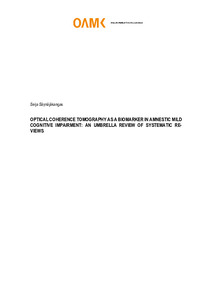Optical Coherence Tomography as a Biomarker in Amnestic Mild Cognitive Impairment: an Umbrella Review of Systematic Reviews
Säynäjäkangas, Seija (2023)
Säynäjäkangas, Seija
2023
All rights reserved. This publication is copyrighted. You may download, display and print it for Your own personal use. Commercial use is prohibited.
Julkaisun pysyvä osoite on
https://urn.fi/URN:NBN:fi:amk-202301291764
https://urn.fi/URN:NBN:fi:amk-202301291764
Tiivistelmä
Introduction:
People with mild cognitive impairment (MCI) are at a higher risk of developing Alzheimer’s disease (AD), one of the most expensive diseases that lead to death and burden society. Therefore, early diagnosis is crucial to implement early and optimal AD treatment and prevent or delay disease progression. As a part of the central nervous system, the retina provides a unique and easy method for studying neurodegenerative disorders.
Purpose: The aim of this review was to screen existing systematic review results to describe the relationship between amnestic MCI and changes in the retinal layers measured with optical coherence tomography (OCT).
Methods: An umbrella review of English literature of systematic reviews was conducted on 1 October 2022 in three electronic databases (PubMed, CINAHL and MED-LINE). Studies of retinal thickness measurements by OCT in ageing people with amnestic MCI were screened from the past ten years. Studies with not related OCT and Alzheimer's disease or MCI were excluded. OCTA and vessel measurements were also excluded. Data results were illustrated on tables and described narratively. In addition, the theoretical background of aMCI and retinal layers measured with OCT was collected using e-books and secondary literature sources.
Results: Seven systematic reviews met the inclusion criteria and demonstrated the link between amnestic MCI and thinning in the retinal layers, measured by optical coherence tomography (OCT). Despite the limitations of the studies, low statistical power and heterogeneity in data results, the clearest evidence of retinal thinning among patients with aMCI had observed in the peripapillary retinal nerve fibre layer (pRNFL), especially in the superior and inferior region, and in ganglion cell - inner plexiform layer (GC-IPL) based on included studies.
Conclusions: Though the retinal layer changes are not disease-specific for aMCI, the retina can provide a window to identify individuals at risk for AD who could benefit from early intervention. OCT could be easily used clinically with other non-invasive tests, like evaluation of functional eye movements and cognitive difficulties, as a risk indicator with multi-professional cooperation.
People with mild cognitive impairment (MCI) are at a higher risk of developing Alzheimer’s disease (AD), one of the most expensive diseases that lead to death and burden society. Therefore, early diagnosis is crucial to implement early and optimal AD treatment and prevent or delay disease progression. As a part of the central nervous system, the retina provides a unique and easy method for studying neurodegenerative disorders.
Purpose: The aim of this review was to screen existing systematic review results to describe the relationship between amnestic MCI and changes in the retinal layers measured with optical coherence tomography (OCT).
Methods: An umbrella review of English literature of systematic reviews was conducted on 1 October 2022 in three electronic databases (PubMed, CINAHL and MED-LINE). Studies of retinal thickness measurements by OCT in ageing people with amnestic MCI were screened from the past ten years. Studies with not related OCT and Alzheimer's disease or MCI were excluded. OCTA and vessel measurements were also excluded. Data results were illustrated on tables and described narratively. In addition, the theoretical background of aMCI and retinal layers measured with OCT was collected using e-books and secondary literature sources.
Results: Seven systematic reviews met the inclusion criteria and demonstrated the link between amnestic MCI and thinning in the retinal layers, measured by optical coherence tomography (OCT). Despite the limitations of the studies, low statistical power and heterogeneity in data results, the clearest evidence of retinal thinning among patients with aMCI had observed in the peripapillary retinal nerve fibre layer (pRNFL), especially in the superior and inferior region, and in ganglion cell - inner plexiform layer (GC-IPL) based on included studies.
Conclusions: Though the retinal layer changes are not disease-specific for aMCI, the retina can provide a window to identify individuals at risk for AD who could benefit from early intervention. OCT could be easily used clinically with other non-invasive tests, like evaluation of functional eye movements and cognitive difficulties, as a risk indicator with multi-professional cooperation.
